Good to Know: Practical Tips for Our Terminal Blocks
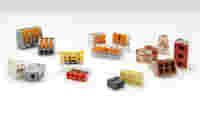
We have summarized all of the important information for safely using WAGO splicing connectors.
Helpful Tips:
- On lighting connectors
- On junction box connectors
- On splicing connectors

We have summarized all of the important information for safely using WAGO splicing connectors.
Copper (Cu) or aluminum (Al): For electrical cables, it’s not a question of faith, but usually an issue of price. Both have their advantages and disadvantages, but when they come together, things can get dicey. However, electricians don’t necessarily need a specialty Al/Cu connector for building installations. With WAGO Alu-Plus Contact Paste, they can connect aluminum and copper conductors using WAGO’s connectors – quickly, easily and reliably.
| Series/Product | Conductor Type | Conductor Range | Voltage/Current | Types of Application |
WAGO 243 MICRO PUSH WIRE® Connectors for Junction Boxes |
| Ø 0.6 to 0.8 mm “e” | 100 V/6 A | For low-current applications such as wiring telephones and doorbells |
WAGO 2273 COMPACT PUSH WIRE® Connectors for Junction Boxes |
| 0.5 to 2.5 mm2 “e” | 450 V/24 A | For installation in building circuits up to 2.5 mm2, even for wiring in tight spaces |
WAGO 773 SPECIAL PUSH WIRE® Connectors for Junction Boxes |
| 2.5 to 6 mm2 “e+m” | 400 V/41 A | For installation of building circuits up to 6 mm2 with fairly large loads a long cable runs |
WAGO 224 Lighting and Inline Connectors |
| Installation side: 1 to 2.5 mm2 “e” | 400 V/24 A | For installations with solid and fine-stranded conductors, e.g., for connecting lights |
| Lighting side: 0.5 to 2.5 mm2 “e+f” | |||
| WAGO 222 CLASSIC Splicing Connectors for all conductor types |
| 0.08 to 2.5 mm2 “e+m” 0.08 to 4 mm2 “f” | 400 V/32 A | For installation with solid, stranded and fine-stranded conductors |
WAGO 221 COMPACT Splicing Connectors for all conductor types |
| 0.2 to 4 mm2 “e+m” 0.14 to 4 mm2 “f” | 450 V/32 A | For installation with solid, stranded and fine-stranded conductors, even for wiring in tight spaces |
0.5 to 6 mm2 “e+m+f” | 450 V/41 A | |||
| ||||
In everyday use, product names are often simplified, for example, the “two-five WAGO” or the “one-five NYM.” When product types use a uniform naming scheme, such simplifications are generally adequate. But if they don’t, technical problems could arise due to incorrect product selection!
An example from real life: The dimensions for installation cables and lines used for power wiring, such as NYM lines, are specified in mm2, i.e. by the conductor cross-section. In contrast, dimensions for conductors used for signal and communication purposes, such as doorbell or J-Y(ST)Y conductors, are indicated in mm, i.e. by the conductor diameter. In order to ensure that splicing connectors can be clearly associated with the appropriate conductors, the corresponding WAGO connectors are also designated in the same way.
The connection range of the 2273 Series COMPACT PUSH WIRE® Junction Box Connectors for power wiring with installation cables and lines is specified in terms of the conductor cross-section: 0.5 to 2.5 mm2 (20–14). The connection range of the 243 Series MICRO PUSH WIRE® Junction Box Connectors for signal and communications lines is specified in terms of the diameters: from 0.4 to 0.5 and 0.6 to 0.8 mm.
If the corresponding unit is ignored, it would be easy to get the impression that the new 2273 Series COMPACT PUSH WIRE® Connector for Junction Boxes could also be used for 0.6 mm and 0.8 mm signal and communication lines, since its larger connection range goes up to 0.5 – But that actually refers to the conductor cross-section of 0.5 mm2 (20 AWG)! When converted to conductor diameter, this corresponds exactly to a diameter of 0.8 mm (0.031 inches). This means that signal and communication lines with a conductor diameter of 0.8 mm (0.031 inches) can be connected with the 2273 Series. The 243 Series MICRO PUSH WIRE® Connector for Junction Boxes is available for all conductors with a diameter of less than 0.8 mm.
NYM conductors are indicated in mm2, i.e. in terms of the conductor cross-section.
In contrast, doorbell or J-Y(ST)Y conductors are indicated in mm, i.e. the conductor diameter.
COMPACT PUSH WIRE® 2273 Series Connectors for Junction Boxes are indicated with conductor cross-sections from 0.5 to 2.5 mm2.
MICRO PUSH WIRE® Junction Box Connectors are specified with diameters from 0.4 to 0.5 and 0.6 to 0.8 mm.
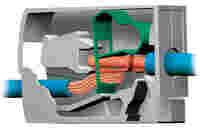
In addition to the connectable conductor types and sizes, the lighting connectors also offer numerous options for connecting fine-stranded conductors to solid conductors: a connection side for solid conductors with cross-sections ranging from 1 mm2 to 2.5 mm2 (18–14 AWG), and a connection side for fine-stranded conductors with cross-sections ranging from 0.5 mm2 to 2.5 mm2 (20–14 AWG).
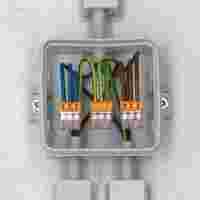
Connecting conductors in a junction box via WAGO PUSH WIRE® connectors, item no. 2273-203.
The following connectors are exempt from these accessibility standards:
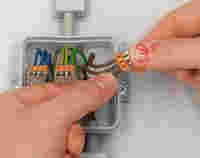
PUSH WIRE® Connections for Wiring Solid Conductors
WAGO Junction Box Connectors with Innovative Tin Plating
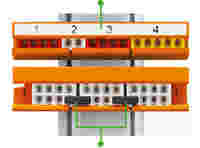
Mounting Carrier: Item No. 2273-500 / Jumper: Item No. 862-482
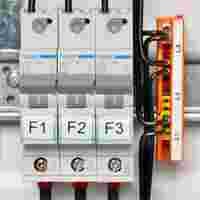
WAGO 2273 Series with Mounting Carrier
Application standards such as DIN VDE 0100-510, DIN VDE 0100-520 and DIN VDE 0100-729 require the following:
Easily accessible, easy to identify, transparently structured and standards-compliant: With the new mounting carrier, electricians can also use WAGO’s popular 221 Series COMPACT Splicing Connectors in distribution cabinets – without violating applicable VDE standards. The easy-to-mark carrier ensures that the compact and user-friendly connectors are securely mounted to DIN-rail.
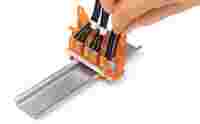
With a new mounting carrier, WAGO has managed to take the advantages users value so much in the WAGO 221 Series and reproduce them in the distribution cabinet itself. The carrier is suited for every 221 Series model. It guarantees easy servicing, inspection, maintenance and accessibility, as well as simple identification and testing of the connected conductors according to VDE 0100-510. The carrier can be snapped onto standard DIN-rails horizontally or vertically, as well as screw-mounted to smooth surfaces. Open on one side, the carrier offers electricians the option of using an operating lever to open the module – even when it is already installed. Conductors can thus be conveniently connected and removed before or after the connector is inserted into the carrier. The design also ensures that a test slot is always accessible.
Inspiration for You
More Helpful Tips
We have summarized all of the helpful information for properly using WAGO’s rail-mount terminal blocks.

We have summarized all of the important information for safe, standards-compliant usage of WAGO products.
Recommended Reading
More Building Technology Applications
Practical tips for installers: Fast, reliable, maintenance-free solutions simplify your everyday tasks.
